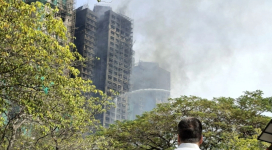
Powerful Typhoon Nesat crashed into northern Philippines Tuesday, causing authorities to order more than 100,000 people to seek shelter from torrential rains and strong winds gusting up to 106 miles per hour in the capital city of Manila.
The typhoon, which halted work due to tremendous floods and downed power lines, has so far resulted in one fatality, a baby, who drowned in the central island province of Cataduanes after falling into a river, the government disaster agency reported. Four fishermen have also been reported as missing.
Nesat made landfall before dawn over eastern mountainous Isabela and Aurora provinces, which face the Pacific Ocean, packing sustained winds of 87 mph, the government weather bureau said.
Heavy downpours and strong winds prompted the closure of government offices, schools and universities in the capital.
Air travel and other transportation were affected as scores of domestic flights were canceled and inter-island ferries grounded, stranding thousands.
The Philippine Stock Exchange and U.S. Embassy were also closed Tuesday.
Along downtown Manila's bay-walk, traffic came to a halt due to high floods that forced residents to wade through water, while waves, as high as palm trees, washed over the seawall and turned a six-lane highway into a swelling brown river.
In other parts of Manila, emergency workers were evacuating river areas that are notorious for flooding. Residents in one neighborhood in Quezon City, a Manila suburb, were fleeing their homes due to rising water from the nearby San Mateo River, local radio reported.
Authorities were also monitoring farming communities at the base of Mayon volcano in Albay, about 212 miles southeast of Manila.
Nesat bore down on the Philippines exactly two years after devastating Typhoon Ketsana struck, killing more than 500 people.
Typhoons are quite common in the Philippines during the rainy season, usually between July and November.







